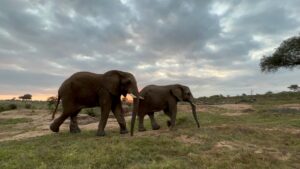Discover more about the latest research project being carried out at HERD, by Marco Reynders, who is studying a Masters at the University of Pretoria.
I’m Marco Reynders. I study at the University of Pretoria. I’m doing a masters in animal production and quality.
My study looks at the effect of feed management on the glucocorticoid concentration of semi-captive elephants…
So what that basically entails and what I’m going to be studying is… testing the stress levels through taking down cycles, testing the stress levels in the semi-captive elephants. Along with that I’m taking feed samples. I’ve taken the eight and most common trees in the area and the five most common grass pieces in the area and I’ve got five sampling points where the grooms or carers take the elephants to walk during a week. I’m breaking the blocks into two or into threes and then sampling on both sides of the block to get a good variation so that I can get an average for the certain trees and grass species in that area by doing that and comparing basically a mineral sample from the dung.
I can compare them and what minerals they retain and which minerals they don’t and what nutrients there are. Along with that I’m doing a test on the fibre context – so neutral detergent fibre acid, detergent fibre and crude fibre. By doing that I can find correlations between that the minerals and the fibres towards the stress and by doing that we can feed them especially at night different types of feed if there’s a correlation with, for example with the higher fibre content we can feed them feeds with high fibre content which will lower the stress in the elephant so it’s all about just maintaining and constantly improving what we’re doing so that we can minimize the stress on the animals which has already been done quite a bit but there’s always room for improvement
What I’ve seen is just in different management acts and what I’ve read in articles and your elephants here is that the stress levels is very closely correlated to those elephants in the wild so if there’s any stress increase it’s very marginal.
Elephants have been something that’s really interested me and the bush in general.
I actually didn’t want to go to university, I always wanted to be a ranger and join anti-poaching things and then my father was like, no you have to study so I studied animal science – that’s the closest I could have gotten to anything wildlife. I also like farming.

And then after my studies I was again confronted with what am I going to go do after this or to further my studies. I felt like I can make a bit of a bigger impact if I do something like this so that’s the reason I started or decided to do a masters. The reason for doing elephants as well is that with the rhino populations getting such a big whack nobody will allow you to do anything with rhinos but what are poachers going to turn back to once the rhinos are diminished – they’re going to go back to ivory and those type of things. Then you’re going to have a lot of orphaned elephants I feel running around the bush. They’re going to have to be caught and taken to places like HERD, where they can actually be either rehabilitated or having as natural as possible a life and by doing this I felt like I can make a bit of a difference.
I’ve read a lot about certain aspects that contribute to their stress, natural aspects such as obviously injuries, run-ins with humans, obviously lions, all those type of things, thunder… I’ve read a lot about that but there’s not a lot of information regarding what the elephants are feeding on and how it affects their stress levels.
There’s a bit more speculation for example in Kenya and Zambia, in those places where the elephants do a lot of crop raiding, for example, because obviously that’s a very very high stress situation for the elephants.
They get shot at and chased and so and it’s been proven before they start crop raiding, by the dung samples, that it increases their stress levels because they know what they’re about to do. There’s certain minerals in those crops that the elephants crave and that’s why they do it, so that’s why the risk is worth the reward but there’s only speculations, no concrete information on that so that is hopefully what I can also add.

So generally like for example if it’s zinc, I’m just using an example, there will be lower zinc compilation because they either take too much of it or there’s not a lot of it and that might make them do crop raiding, for example or it will increase their stress levels because they obviously have a craving. If you have a craving as a person you go out and you can go get it but they can’t necessarily go get it, so for example what I’m hoping then, if we know during winter times that elephant stress levels are high in winter compared to summer, we can say to Tigere, the carers must rather take them into these blocks more often because that’s where a higher cobalt is in the whatever tree and they need that so that will lower their stress so they can walk certain areas a bit more.
During different times of the year elephants generally in summer eat more grass compared to in the winter, where the fibre will increase because they’re eating more twigs and bark and even so trying to manage that will be interesting to see
The carers have good account keeping of what is happening through the day of the elephants – as of yet the elephants haven’t really in the time I’ve been here really run into any lions or other wild elephants which sometimes will influence it but for example last month Jabulani’s leg was injured so I will take notes of that and if Jabulani’s stress levels are suddenly much higher we know that is the reason so we try to take as many notes of these things as possible because well they do play a role.

For now I’m just storing, once I’ve done all my dung sampling then I will start analyzing them for stress. What I’ll do is probably end up pulling each sampling period together to get a average value for that week and then we use the average value for that month and then we’ll graph it and then get how the stress levels fluctuate if there is a fluctuation.
So by doing this it not only helps HERD, but other places can use the same structure or methods or idea from what I’m hopefully doing to decrease the elephants’ stress levels and make it more natural as possible basically.




 Comment
Comment






